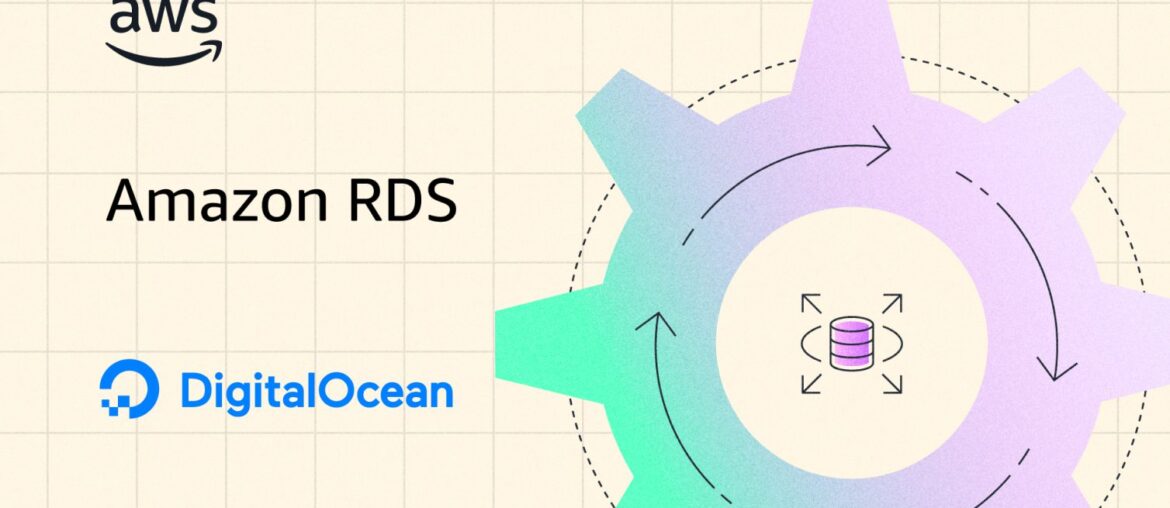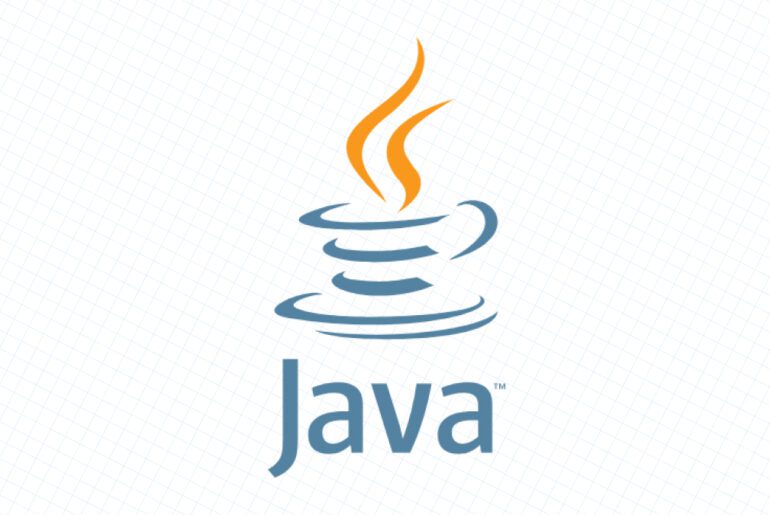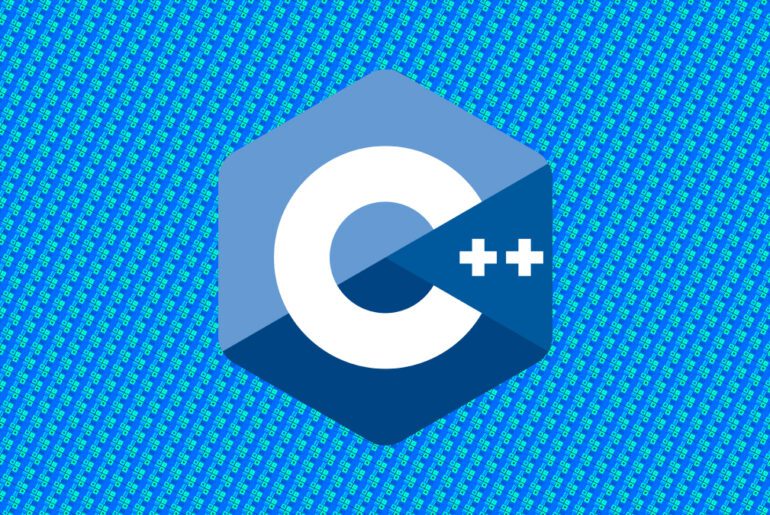When I first started running production web apps (around 2015), large parts of the “cloud database” conversation centered on whether to self-manage MySQL/PostgreSQL or use something like Amazon RDS. Over the years, as AWS matured, RDS became a standard default choice. Meanwhile, smaller players like DigitalOcean added “managed databases” features more recently, bringing a simpler and lower-cost alternative.
Fast forward to 2025: the cloud landscape is more crowded, prices have shifted, and new requirements (global scale, data sovereignty, compliance, specialized performance) are pushing teams to reevaluate: is AWS RDS always the safe bet? Or is DigitalOcean’s managed offering “good enough” — or even preferable — in many cases?
In this guide I’ll walk you through what I found when comparing Amazon RDS and DigitalOcean’s managed database services today. I’ll show you where each shines, how the trade-offs look, and how to choose for your use case. You don’t need to be a database wizard — I’ll spell things out clearly.
Before diving into feature comparisons, it helps to understand how both systems evolved and why some of their trade-offs exist.
Amazon RDS
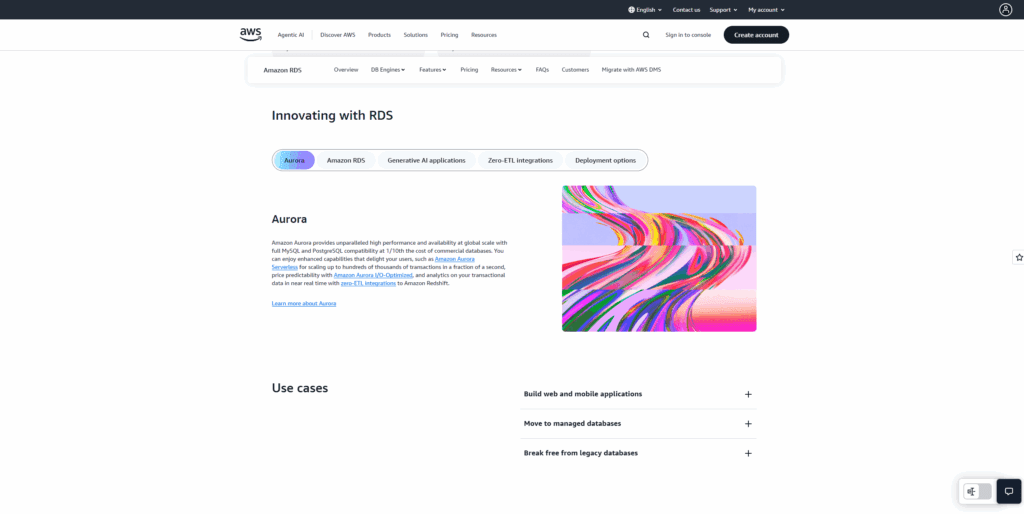
AWS launched RDS in October 2009, initially for MySQL only. Over time, AWS added support for Oracle, Microsoft SQL Server, PostgreSQL, MariaDB, and later Amazon’s own Aurora engines. The motivation was to give customers the benefits of a managed relational database — automated backups, patching, replication, scaling — without requiring full on-premises DBA work. Amazon also steadily built out advanced capabilities: Multi-AZ, cross-region replication, Read Replicas, Aurora’s auto-scaling and decoupled storage, and integrations with the wider AWS ecosystem (IAM, monitoring, VPC, etc.). Because AWS’s core business is infrastructure, RDS has had years of investment, so many corner cases and scale challenges have been battle-tested.
DigitalOcean
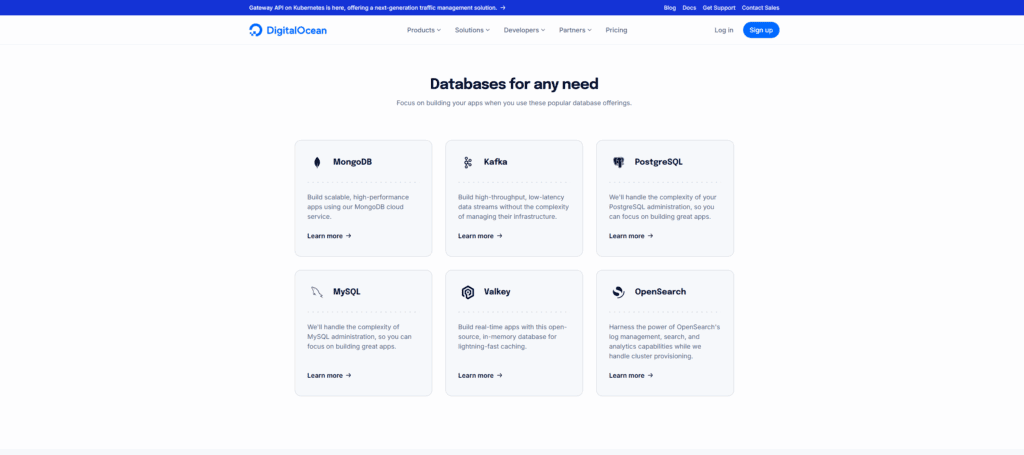
DigitalOcean launched in 2012 as a developer-friendly, low-cost cloud geared toward small apps, startups, and simpler workloads For years, its core offerings were droplets (VPS), storage, and Kubernetes. The “managed databases” product is newer — one of DigitalOcean’s pushes to provide more “platform as a service” for users who don’t want to tinker with databases at the OS level. As of mid-2025, DigitalOcean’s managed database offering supports PostgreSQL, MySQL (and some others depending on region) with built-in backups, automatic failover, encryption, and scaling features. But its feature set is leaner than RDS, and many of its newer capabilities are still catching up.
So as you see, RDS is the veteran with deep ecosystem support, while DigitalOcean’s offering is the younger contender aiming for simplicity, predictability, and lower cost.
Core comparisons: how they differ in 2025
Below, I walk through key dimensions I consider when choosing between RDS and DigitalOcean’s managed databases. Use these to map them to your requirements.
Ecosystem and integration
One of the biggest, often overlooked, advantages of RDS is how deeply it ties into the rest of AWS’s services. If your app is already running on EC2, Lambda, or you use AWS IAM, CloudWatch, VPC, KMS, etc., RDS slots in almost seamlessly. You can often wire up monitoring, alerting, security, and networking uniformly across your stack.
DigitalOcean’s ecosystem is smaller. If you’re using their droplets, storage, or networking, the integration is decent — but if you also have services outside of DigitalOcean (or plan to migrate), you may lose some of that tight coupling.
Takeaway: If you’re already “in AWS,” RDS gives you synergy. If you’re starting fresh or want multi-cloud flexibility, DigitalOcean gives you less overhead and simpler abstractions.
Feature completeness & maturity
Over time, AWS has added many advanced features to RDS:
- Automated backups, snapshots, point-in-time recovery (PITR) up to 35 days retention.
- Multi-AZ and synchronous standbys for high availability.
- Cross-region replication and Global Database in Aurora.
- Read replicas (up to 15 in many engines).
- Scaling of compute and storage (often with minimal downtime).
- Fine-grained performance controls, optimized IOPS, parameter groups, etc.
DigitalOcean also supports many of these, but in a simpler and more constrained manner. Their clusters typically include daily backups, standby nodes for high availability, SSL encryption, and automated failover. You can scale the cluster and resize, though automatic scaling is more limited. Some optional features — global multi-region, highly advanced tuning, proprietary engines — are simply not available or lagging behind.
| Metric / Feature | Amazon RDS (incl. Aurora) | DigitalOcean |
|---|---|---|
| Supported Engines | MySQL, PostgreSQL, MariaDB, Oracle, SQL Server, Aurora | PostgreSQL, MySQL (others limited by region) |
| High Availability | Multi-AZ, Aurora multi-zone with auto-failover | Standby node with automated failover |
| Global Replication | Cross-region replicas, Aurora Global Database | Not currently supported |
| Scaling Options | Vertical scaling, Aurora auto-scaling, storage scaling | Vertical scaling only, limited auto-scaling |
| Backups & PITR | Snapshots, PITR up to 35 days | Daily backups, PITR limited (engine-specific) |
| Read Replicas | Up to 15 (Aurora) | Up to 2–5 depending on plan |
| Ecosystem Integration | Full AWS suite (IAM, CloudWatch, VPC, etc.) | Limited to DO products (Droplets, VPC, Spaces) |
In short: RDS is feature-rich and battle-tested; DigitalOcean is lean but sufficient for many use cases.
Performance, scaling, and limits
Because AWS supports very large instance types and scalable storage, RDS can handle enormous production workloads. You can push to very high IOPS, large memory, and distribute reads with replicas. Aurora’s architecture decouples compute and storage, giving further performance flexibility.
DigitalOcean’s managed DBs are built to scale for many medium use cases, but when you push into very high concurrency or extreme datasets, you may hit ceiling limitations or face performance trade-offs. Comparing benchmarks, we saw that for specialized workloads (like time-series) alternatives outperform standard Postgres on RDS, but those are niche cases.
One performance dimension often forgotten is network egress cost and transfer pricing. For example, AWS may charge more for cross-zone or outbound data, whereas DigitalOcean has more predictable, modest rates (e.g. $0.01/GB outbound after the first 1 TB) in many cases.
Pricing & cost predictability
This is where things often shift decisions for smaller or growing teams. RDS pricing is flexible but can become complex: you pay for instance type, storage, I/O operations, backup storage beyond free quotas, data transfer, etc. As your workload scales, those numbers can jump.
DigitalOcean aims for simplicity. Their managed database plans tend to bundle more components and avoid some of the hidden costs. Their pricing is relatively transparent and lower for smaller sized workloads.
That said, once your usage becomes large, the cost advantages shrink — you’re paying for things RDS does with deeper infrastructure, and RDS’s options might justify its higher cost.
| Metric | Amazon RDS | DigitalOcean |
|---|---|---|
| Entry-level Price (smallest HA setup) | ~$70–90/month (db.t3.small Multi-AZ PostgreSQL) | ~$15–30/month (basic managed Postgres cluster) |
| Network Egress | ~$0.09/GB outbound (first GB free) | ~$0.01/GB outbound after 1TB free |
| Storage | Separate charge ($0.115/GB for gp2 in us-east-1) | Included in cluster pricing up to quota |
| Max Instance Size | 64+ vCPUs, >1TB RAM (Aurora, high-end RDS) | 64 vCPUs, 256GB RAM (upper-tier managed nodes) |
| SLA / Availability | 99.95%–99.99% depending on config | ~99.95% with HA standby |
| Latency (same region typical) | 1–3 ms (Aurora local read) | 3–5 ms typical |
Reliability, availability & SLAs
RDS has strong high availability features (Multi-AZ, failover within seconds) and SLAs. Aurora’s design adds even more redundancy and fault tolerance (e.g. six-way replication across AZs)
DigitalOcean offers automated failover and standby nodes; even basic plans include resiliency features. However, because DigitalOcean has fewer availability zones globally (or fewer options per region), you may have less redundancy in certain geographies.
In practice, reliability with DigitalOcean can be quite good for many applications — just be aware of the limits and guarantees in your region.
Usability, operations, and developer experience
If you want something that “just works” with minimal configuration, DigitalOcean often feels lighter and cleaner. The UI is simpler, fewer moving parts to think about, fewer optional knobs you accidentally break.
But RDS gives you more control. If you’re willing to learn its abstractions (parameter groups, option groups, read replica tuning, snapshot scheduling), you can optimize things deeply. Also, because AWS has so many adoption resources, documentation, community, and scale patterns, it’s easier to find help.
For migrations, going from DigitalOcean → RDS is quite possible (e.g. using logical dump + replication). But there is friction when migrating out of AWS because of lock-in or dependencies on AWS-specific features.
Decision scenarios: when to choose which
Here’s how I think through it when I’m building or migrating:
- If my app is small-to-medium, cost sensitivity is high, I want simple DevOps, and I don’t expect huge scale immediately → I lean DigitalOcean
- If I expect to scale massively, need global presence, need compliance, or already have heavy AWS usage → I lean RDS
- If I’m building a prototype or MVP, starting on DigitalOcean and later migrating to RDS is viable
- But if I want to avoid migration pain, sometimes going straight to RDS is wiser
To make it more concrete, imagine:
- Startup / small SaaS with single region: DigitalOcean gives you enough performance, simple pricing, less ops overhead, and you can defer the complexity until you grow.
- Growing product with multi-region demand, compliance, or unpredictable workloads: Amazon RDS (especially via Aurora) gives you more headroom, more advanced options, and stronger guarantees.
- Hybrid or edge use cases: sometimes you might even split – use DigitalOcean in one geography for cost or latency, and RDS in another.
Here’s a simple flow I like to use to reason it:
flowchart TD
A[You need a managed relational database] --> B{Is your workload small-to-medium?}
B -- Yes --> C{Do you already use AWS heavily?}
C -- Yes --> UseRDS
C -- No --> UseDigitalOcean
B -- No --> UseRDS
UseRDS[Choose Amazon RDS / Aurora]
UseDigitalOcean[Choose DigitalOcean Managed DB]
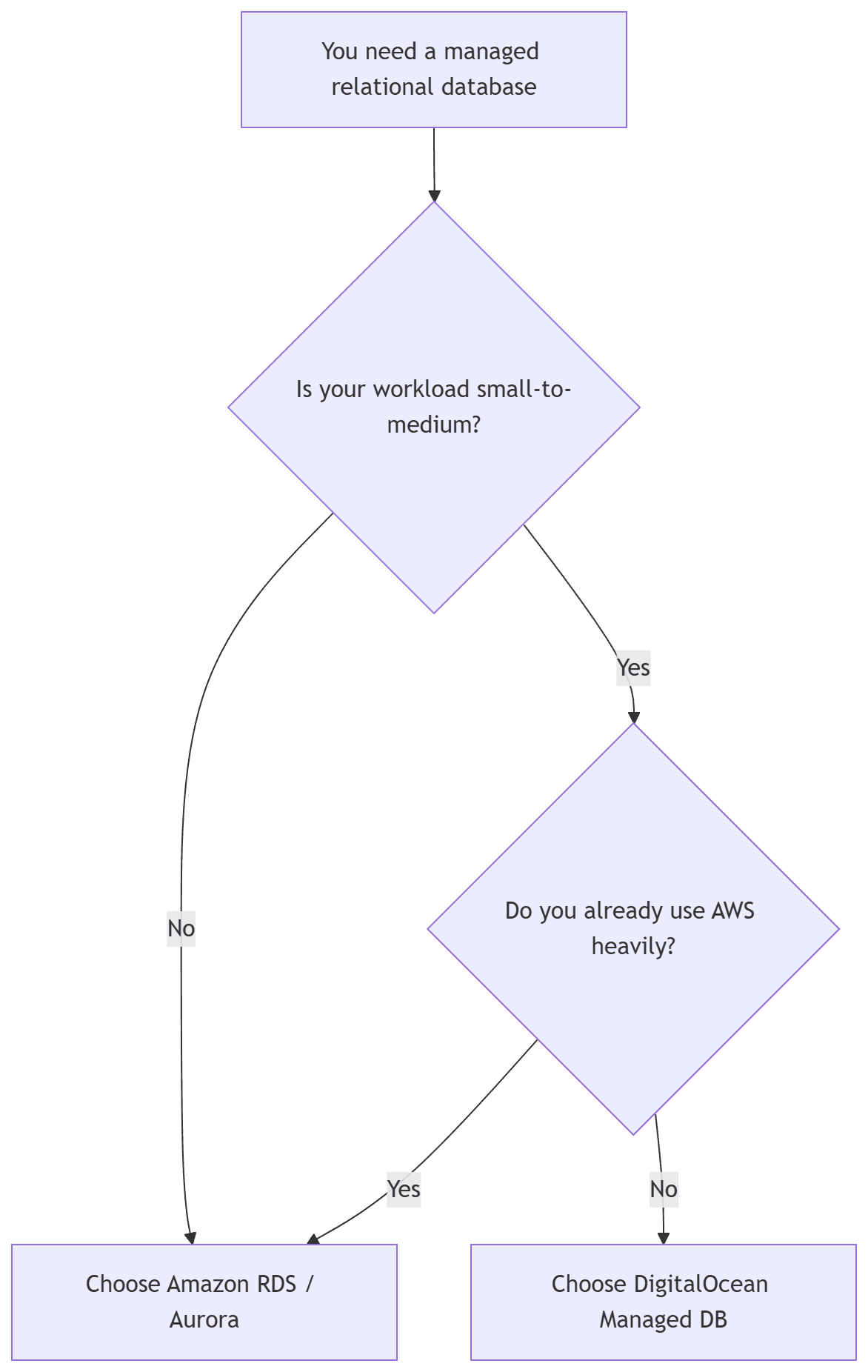
I’ve used that decision tree on a few projects, and usually the path is clear once you estimate your expected scale and ecosystem footprint.
Caveats, tips, and gotchas
- Always simulate or estimate your I/O load, not just CPU or memory. Sometimes costs explode due to IOPS.
- When choosing region and availability zones, check what DigitalOcean supports in your target geography.
- Read the SLA fine print. Uptime guarantees, failover times, backup windows — make sure they align with your needs.
- Benchmark early. For your workload, run test queries on both platforms to see latency, throughput, and behavior under load.
- Plan your backups and restore drills. Even though managed systems handle backups, being confident your recovery process works matters.
- Think about migration/exit path. If you adopt features that lock you in (AWS-only features, Aurora-specific features), it will cost more to leave.
- Bulk data transfer (egress) is sometimes underestimated and can surprise your budget.
Summary & final thoughts
In 2025, the gap between Amazon RDS and DigitalOcean Managed Databases is narrowing in the “good enough for many use cases” category. If your needs are modest and you value simplicity and cost predictability, DigitalOcean is a compelling option. But for larger scale, global deployments, high availability, or deep integration with cloud infrastructure, RDS (or Aurora) still leads.
When I choose between them today, I start by mapping my scale, growth trajectory, geographic distribution, cost sensitivity, and ecosystem. If everything points toward lean and simpler, DigitalOcean wins. If I see risk of hitting ceilings or needing advanced features, I go with RDS from the start.


